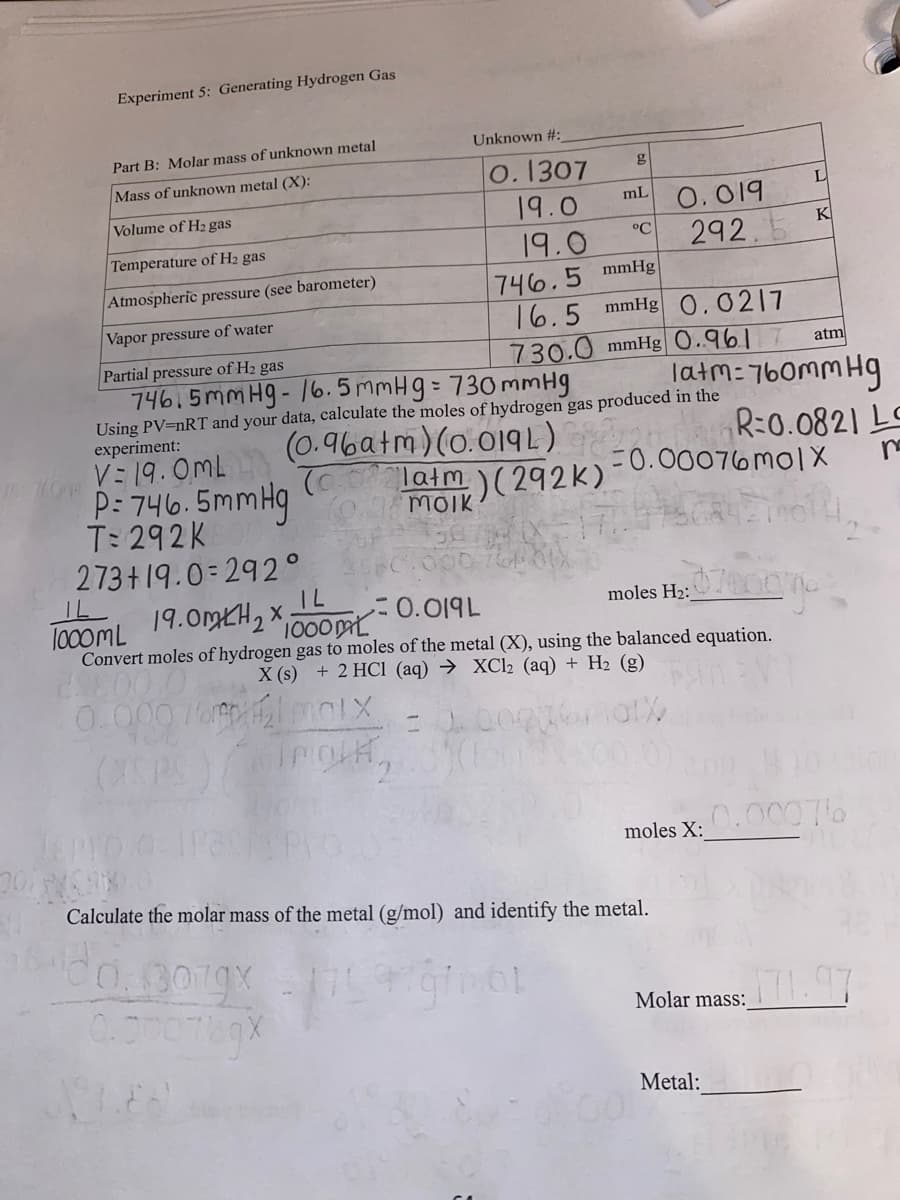Experiment 5: Generating Hydrogen Gas Part B: Molar mass of unknown metal Mass of unknown metal (X): Volume of H₂ gas Temperature of H₂ gas Atmospheric pressure (see barometer) Vapor pressure of water Partial pressure of H₂ gas 746.5mmHg-/6.5mmHg = 730 mmHg Using PV=nRT and your data, calculate the moles of hydrogen gas produced in the experiment: (0.96atm)(0.019L) V=19.0mL latm molk ;)(292K) 35-2 158 P=746.5mmHg T: 292K 273+19.0=292° Unknown #: TEPYO 0: 2017CA10.0 0.1307 19.0 19.0 g mL °℃ 0.019 292 746.5 mmHg 16.5 mmHg 0.0217 730.0 mmHg 0.961 moles H₂: atm latm: 760mmHg 07anaje 19.0m₂ x IL 2 1000ML 0.019L 1000mL Convert moles of hydrogen gas to moles of the metal (X), using the balanced equation. X (s) + 2 HCl (aq) → XCl₂2 (aq) + H₂ (g) 0.000/6₂1 marx = 0.0000 lot% (XSPS) IMOLK Calculate the molar mass of the metal (g/mol) and identify the metal. 0.3079x1759 ginal 0.000769x L 0.00076 mol X moles X: K R=0.0821 LC m Metal: 0.00076 Molar mass: 171.97
Experiment 5: Generating Hydrogen Gas Part B: Molar mass of unknown metal Mass of unknown metal (X): Volume of H₂ gas Temperature of H₂ gas Atmospheric pressure (see barometer) Vapor pressure of water Partial pressure of H₂ gas 746.5mmHg-/6.5mmHg = 730 mmHg Using PV=nRT and your data, calculate the moles of hydrogen gas produced in the experiment: (0.96atm)(0.019L) V=19.0mL latm molk ;)(292K) 35-2 158 P=746.5mmHg T: 292K 273+19.0=292° Unknown #: TEPYO 0: 2017CA10.0 0.1307 19.0 19.0 g mL °℃ 0.019 292 746.5 mmHg 16.5 mmHg 0.0217 730.0 mmHg 0.961 moles H₂: atm latm: 760mmHg 07anaje 19.0m₂ x IL 2 1000ML 0.019L 1000mL Convert moles of hydrogen gas to moles of the metal (X), using the balanced equation. X (s) + 2 HCl (aq) → XCl₂2 (aq) + H₂ (g) 0.000/6₂1 marx = 0.0000 lot% (XSPS) IMOLK Calculate the molar mass of the metal (g/mol) and identify the metal. 0.3079x1759 ginal 0.000769x L 0.00076 mol X moles X: K R=0.0821 LC m Metal: 0.00076 Molar mass: 171.97
Principles of Modern Chemistry
8th Edition
ISBN:9781305079113
Author:David W. Oxtoby, H. Pat Gillis, Laurie J. Butler
Publisher:David W. Oxtoby, H. Pat Gillis, Laurie J. Butler
Chapter10: Solids, Liquids, And Phase Transitions
Section: Chapter Questions
Problem 35P
Related questions
Question
Need help answering all with given data

Transcribed Image Text:Experiment 5: Generating Hydrogen Gas
m:7609
Part B: Molar mass of unknown metal
Mass of unknown metal (X):
Volume of H₂ gas
Temperature of H₂ gas
Atmospheric pressure (see barometer)
Vapor pressure of water
Partial pressure of H₂ gas
746.5mmHg- /6.5mmHg = 730 mmHg
Using PV=nRT and your data, calculate the moles of hydrogen gas produced in the
experiment:
(0.96atm)(0.0194)
V=19.0mL
latm
molk
;)(292K)
2:52 158
P=746.5mmHg
T: 292K
273+19.0=292°
TEPTO 0:
Unknown #:
201310.0
g
0.3019x
0.000769x
0.1307
19.0
19.0
746.5 mmHg
16.5 mmHg 0.0217
730.0 mmHg 0.961
mL
°℃
0.019
292
moles H₂:
drenaje
19.0m₂ x
IL
2 1000ML
0.019L
1000mL
Convert moles of hydrogen gas to moles of the metal (X), using the balanced equation.
X (s) + 2 HCl (aq) → XCl₂2 (aq) + H₂ (g)
0.000/m1 maix
= 0.0000 101%
(XSPS)
IMOLK
Calculate the molar mass of the metal (g/mol) and identify the metal.
3079x75gin61
atm
latm: 760mmHg
L
0.00076molX
moles X:
K
R=0.0821 LC
m
Metal:
0.00076
Molar mass: 171.97
Expert Solution
This question has been solved!
Explore an expertly crafted, step-by-step solution for a thorough understanding of key concepts.
Step by step
Solved in 3 steps with 3 images

Knowledge Booster
Learn more about
Need a deep-dive on the concept behind this application? Look no further. Learn more about this topic, chemistry and related others by exploring similar questions and additional content below.Recommended textbooks for you

Principles of Modern Chemistry
Chemistry
ISBN:
9781305079113
Author:
David W. Oxtoby, H. Pat Gillis, Laurie J. Butler
Publisher:
Cengage Learning

Introductory Chemistry: A Foundation
Chemistry
ISBN:
9781337399425
Author:
Steven S. Zumdahl, Donald J. DeCoste
Publisher:
Cengage Learning

Chemistry: Principles and Reactions
Chemistry
ISBN:
9781305079373
Author:
William L. Masterton, Cecile N. Hurley
Publisher:
Cengage Learning

Principles of Modern Chemistry
Chemistry
ISBN:
9781305079113
Author:
David W. Oxtoby, H. Pat Gillis, Laurie J. Butler
Publisher:
Cengage Learning

Introductory Chemistry: A Foundation
Chemistry
ISBN:
9781337399425
Author:
Steven S. Zumdahl, Donald J. DeCoste
Publisher:
Cengage Learning

Chemistry: Principles and Reactions
Chemistry
ISBN:
9781305079373
Author:
William L. Masterton, Cecile N. Hurley
Publisher:
Cengage Learning


Chemistry: An Atoms First Approach
Chemistry
ISBN:
9781305079243
Author:
Steven S. Zumdahl, Susan A. Zumdahl
Publisher:
Cengage Learning

Introduction to General, Organic and Biochemistry
Chemistry
ISBN:
9781285869759
Author:
Frederick A. Bettelheim, William H. Brown, Mary K. Campbell, Shawn O. Farrell, Omar Torres
Publisher:
Cengage Learning